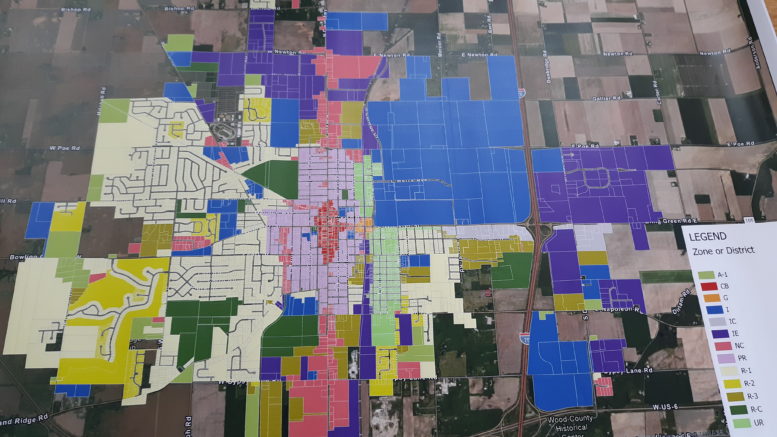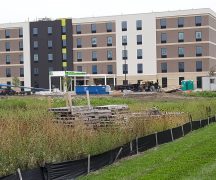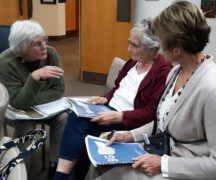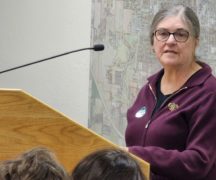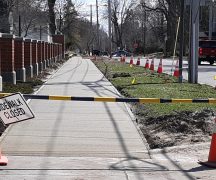By JAN LARSON McLAUGHLIN
BG Independent News
The zoning code update is now on its way to Bowling Green City Council – after residents took one more opportunity to criticize or praise the plan last week.
The city planning commission listened to concerns about businesses in residential neighborhoods, housing density that may promote more rental properties, electric signage, backyard chickens and the city’s walkability.
They also heard support for neighborhood businesses, community gardens, and historic preservation.
Mayor Mike Aspacher thanked the planning commission for digging into the details of the zoning update and giving the community multiple meetings to offer input.
“I wanted all the commission members to take this very seriously,” commission Chairman Bob McOmber said at the end of the meeting. “It might be the most important thing we do on the planning commission. I think everybody took those words to heart.”
The proposed zoning code now goes to City Council, which will have the final word on the update. The changes are intended to make the community more livable for residents and businesses. Among the goals of the update are:
- Simplify and modernize the code.
- Remove barriers to new businesses.
- Create a walkable urban center.
- Increase housing options.
- Establish a gateway between BGSU and downtown.
- Create a local identity.
- Maintain neighborhoods.
- Increase health and fitness opportunities.
McOmber tried to clear up lingering misrepresentations of the zoning update – especially in the proposed Pedestrian Residential zoning areas, which will allow some types of businesses to be located in residential neighborhoods.
“Somebody can’t just plop down any kind of business they want to,” he said. “Certainly the intent is to improve the quality of life in our city.”
“There are rumors that seem to persist, that if we adopt this proposed zoning code that people will be severely impacted by it – maybe forced to tear down their property, that kind of thing,” McOmber said. All not true, he said.
Even after the update is adopted, the city will continue to monitor its effects and consider necessary amendments, McOmber added.
Citizen concerns continue
One of the most controversial sections of the update has been the new Pedestrian Residential zoning which stretches a few blocks on each side of Main Street from Poe Road to Napoleon Road. Some residents of those areas object to their neighborhoods being subjected to some small businesses.
“I get what you’re going after, but I don’t know what could land right next to my house,” said Brian Craft, who lives on South Maple Street. If co-mingling of residences and businesses is desired, then why isn’t it being done in other neighborhoods, he asked.
“If this proposal is such a great idea and a way of attracting new property owners, why is it not proposed in Stone Ridge, Hillcrest or Westgate?” Craft said.
Craft, a former city employee, said an organizational chart used to hang in City Council chambers.
“Citizens were at the top – and you work for the citizens,” he said to the planning commission. “I don’t think anyone has been really listening to the people who are coming and talking about our concerns.”
Craft questioned if most citizens are aware of the zoning code update.
“I bet most people don’t even know what is going on in the city,” he said. “I’m concerned most people are going to figure this out when it’s too late.”
David Wilson, a resident of Eberly Avenue, voiced similar concerns.
“Please listen to us. Otherwise you force us to either leave or ask for a referendum,” Wilson said. “We’re the citizens who live in these neighborhoods, who pay the taxes in these neighborhoods.”
Several city leaders do reside in the proposed pedestrian residential areas, including three members of City Council, at least three members of the planning commission, at least three on zoning board of appeals, and four on the historic preservation commission.
Neighborhood businesses not a new idea
Sean Brennan, who lives downtown, likes the idea of businesses tucked in with residences. And he challenged the characterization of the concept by some citizens as a “social experiment.”
He pointed out that Bowling Green has a history of neighborhood commerce, especially along the now abandoned railroad track west of Main Street.
“We’re not talking something new here,” Brennan said. “There were stores all over this town.” He listed off a convenience store on Pearl, the carryout on North Grove, the ice cream shop on Adams, and the grocery on Crim.
“This is not a social experiment,” he said. “As a society, we need to encourage living neighborhoods, neighborhoods that are walkable and cyclable, with access to daily functions of our life.”
“I think you’re doing the right thing,” Brennan told the planning commission.
Anesa Miller, who lives on North Main Street, said she doesn’t have a problem with businesses near her home – a dry cleaners, hair salon, and beer brewery.
“I have never been bothered by the businesses in my neighborhood,” she said. “I still miss the North Grove Carryout. It was heartbreaking when we lost that.”
Greater density worries some residents
Christen Giblin, who lives on North Prospect Street, already lives in an area heavy with rental properties. She fears that the zoning code’s densification language will lead to even more.
“I love living in Bowling Green. I love my neighborhood,” she said, admitting that some years can be more challenging than others, depending on who the tenants are next door.
“We don’t need more multiple family homes,” Giblin said.
She voiced concern that the density criteria was “dreamed up by landlords who want to rent more properties.”
Giblin also questioned the wisdom of the pedestrian residential zoning.
“I’m not sure businesses and residences should mix,” she said. “I really do wish you would listen to people living in this part of town.”
Anesa Miller said she has invested in her home and worries that more owner-occupied homes will become rentals.
“I do see some deterioration in my neighborhood,” as more houses transition to rental properties, Miller said.
Real reason BG growth is stagnant
The lack of “walkable” neighborhoods with businesses is not the cause of slow growth in Bowling Green, according to Craft.
“We are losing people to Perrysburg, and I don’t think it’s because they have better coffee,” he said.
The elephant in the room is the need for new school buildings, Craft said. When people look for a community to move to, schools carry a lot of weight.
“They are going to look at schools first,” he said. “It’s not about coffee shops in my neighborhood.”
So if Bowling Green is serious about attracting and retaining residents and business, the focus should be put on schools, Craft suggested.
“We need a new school levy that will make our buildings equal or better to that school up north.”
Seeing the light on electronic signs
Rose Drain, who lives on East Court Street, voiced concerns that more businesses in neighborhoods could mean more light from electronic signs disturbing residents in their homes.
“That sign is really annoying,” she said of the electronic sign at a church across the street from her home. “I would hate to see more signs illuminating our neighborhood like that one.”
While the proposed zoning update addresses the brightness of electronic message signs, the planning commission suggested that such signs not be permitted in residential areas.
Walkability is a state of mind – not just sidewalks
Penny Evans-Meyer, who lives on Buttonwood Avenue, believes the city should be working to make Bowling Green more walkable throughout the city – not just in the pedestrian residential blocks that run adjacent to Main Street.
To do that, the city would have to repair sidewalks, paint crosswalks at every intersection, enforce pedestrian rights, and provide mass transit. Putting businesses in neighborhoods will not make them more walkable, she said.
Nolan Nicaise, urban and environmental planner at ZoneCo which is working with the city on the zoning update, said several features help promote walkability – like nearby destinations, benches, trees, curb cuts, lighting and protected crosswalks.
But planning commission member Abhishek Bhati said the community needs to adopt a different attitude about walking to destinations in the city.
Bhati, who frequently walks in the community, said he finds motorists to not be pedestrian-friendly, even when he is accompanied by his baby and his dog.
“Those are two good things to stop drivers, and they still don’t stop,” he said.
“It’s an attitude and we know how hard it is to change an attitude, and this town doesn’t have this attitude,” Bhati said.
Backyard chickens and community gardens
Also at last week’s meeting, the planning commission considered “household agriculture” options in the zoning code.
The commission recommended to City Council that community gardens be added as a conditional use in residential areas. Residents could be allowed to adopt plots to plant and harvest for their own use, to give away, or to sell.
The issue of backyard chickens, which caused some feathers to fly nearly a dozen years ago, was not so easily resolved. McOmber and Judy Ennis shared their stories of the controversy caused by the topic.
McOmber acknowledged that perhaps the issue of backyard chickens should be revisited. However, he suggested that it be dealt with as a separate matter since otherwise it could delay the adoption of the zoning update.
Aiming for higher limits
After much discussion, the planning commission also voted last week to ask City Council to closely review building height restrictions – to see if the limits should be eliminated, modified, or remain as they are.
Planning commission member Mark Remeis talked about how the height restrictions have made it tough for developers.
“It’s turned development away,” he said, talking about the Market Square and Tropical Smoothie buildings being limited to two stories.
The new zoning update allows for greater flexibility.
“I feel like we’ve made a lot of progress since that happened,” Planning Director Heather Sayler said. “We’re not a Chicago or a New York City.”
Nate Spitler agreed that the city should not allow “a monstrosity of a 10-story building next to a two-story.” But the current limits are an “unnecessary restraint” on quality development, Spitler said. Such limits may deter developers from even considering Bowling Green, he added.
However, some members were uncomfortable with removing all height limits.
“The idea of not having any height restrictions still makes me nervous,” McOmber said.
“I think we need them,” Tom Stalter said, adding that a process is already in place for specialized developments to go before the zoning board of appeals.

